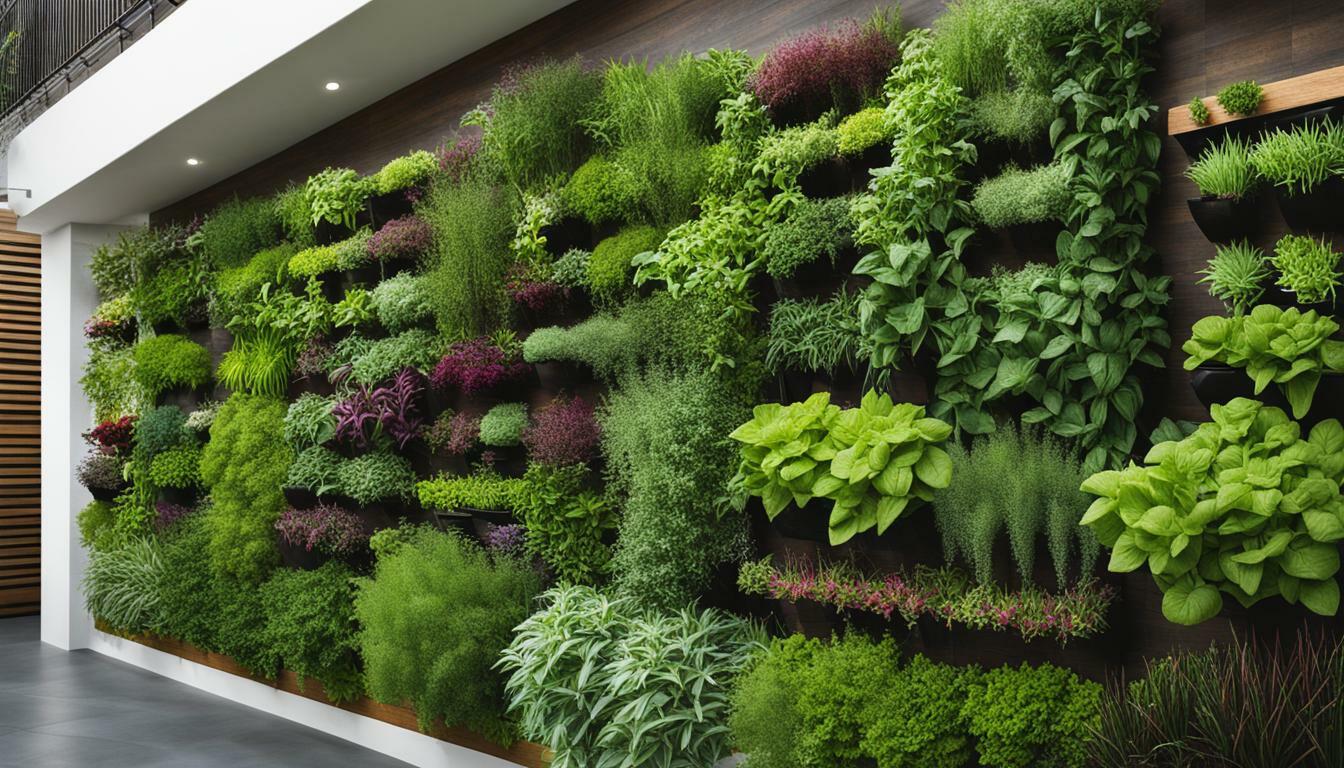Are you looking to make the most of your space and cultivate flavorful herbs? Consider creating a vertical garden for herbs to optimize your gardening area. With a vertical garden, you can maximize the use of your available space, whether you have a small balcony or a limited backyard. This innovative gardening technique allows you to grow herbs vertically, using walls, trellises, or hanging structures to create a beautiful and functional herb garden.
Key Takeaways:
- Vertical gardening is an efficient way to maximize space and grow herbs.
- By using walls, trellises, or hanging structures, you can create a beautiful and functional vertical herb garden.
- Choosing the right herbs based on sunlight, space, and growth habits is crucial for the success of your vertical garden.
- Designing an aesthetically pleasing layout and selecting suitable gardening techniques and structures are important considerations for vertical herb gardening.
- Proper care and maintenance, including watering, fertilizing, pruning, and pest control, are essential for the health of your vertical herb garden.
- Harvesting herbs from your vertical garden and utilizing them in cooking, teas, and homemade remedies can be a rewarding experience.
- Common issues in vertical herb gardening can be addressed through troubleshooting techniques.
- Get inspired with creative and innovative ideas for vertical herb gardens to add a unique touch to your space.
- Vertical herb gardening is particularly beneficial in urban environments, where space is limited.
- Vertical gardening also offers environmental advantages, including reduced water usage and improved air quality.
The Benefits of Vertical Gardening for Small Spaces
Vertical gardening is a practical solution for maximizing your garden space in small areas, offering several benefits for herb enthusiasts with limited space. By utilizing vertical space, you can grow a variety of herbs without taking up valuable floor space. Here are some of the advantages of vertical gardening for small spaces:
- Efficient use of space: Vertical gardening allows you to grow more herbs in a smaller area. By utilizing walls, trellises, or hanging gardens, you can create a vertical oasis of greenery.
- Convenience: Having your herbs grown vertically makes it easier to tend to them and harvest them. You can easily reach the plants without having to bend over or crawl on the ground.
- Aesthetic appeal: Vertical gardens can be visually stunning and add a unique element to your small space. They can transform plain walls into vibrant green backdrops, creating a beautiful and inviting atmosphere.
By incorporating vertical gardening into your small space, you can enjoy all the benefits of growing herbs without the limitations of traditional gardening methods. Whether you have a balcony, a small patio, or just a window ledge, vertical gardening offers a practical and efficient solution for maximizing your herb-growing potential.

The Versatility of Vertical Gardens
Vertical gardens come in various forms, allowing you to choose the structure that best suits your space and aesthetic preferences. Some popular vertical gardening techniques and structures include:
- Trellises: These provide vertical support for climbing plants and can be attached to walls, fences, or standalone structures.
- Hanging gardens: These involve suspending pots or planters from a ceiling, wall hooks, or a sturdy frame.
- Wall-mounted planters: These attach directly to walls, creating a living wall of herbs.
Each structure offers its own unique advantages and allows you to experiment with different designs and layouts to create your ideal vertical herb garden.
| Advantages of Vertical Gardening for Small Spaces | How to Achieve It |
|---|---|
| Efficient use of space | Utilize vertical structures like trellises and hanging gardens |
| Convenience | Choose wall-mounted planters or hanging gardens for easy access |
| Aesthetic appeal | Create a living wall with a variety of herb plants |
With the versatility of vertical gardens, you can customize your herb-growing space to fit your needs and preferences, making the most of your limited space.
Choosing the Right Herbs for Your Vertical Garden
Selecting the right herbs for your vertical garden is crucial to ensure successful growth and a bountiful harvest in limited space. With vertical gardening, you can create a thriving herb garden even if you have a small balcony or a tiny window ledge. By utilizing vertical space, you can maximize your garden’s potential and enjoy fresh herbs all year round.
When choosing herbs for your vertical garden, consider their sunlight requirements, space availability, and growth habits. Some herbs thrive in full sun, while others prefer partial shade. Assess the area where you plan to install your vertical garden and choose herbs that are suitable for the available light conditions. For example, mint, parsley, and chives are shade-loving herbs that can be grown successfully in a vertical garden with limited sunlight.
Another factor to consider is the growth habits of the herbs. Some herbs, such as basil and thyme, have a compact growth habit, making them ideal for vertical gardening. On the other hand, herbs like rosemary and sage can become large and bushy, so they may require more space or regular pruning to keep them in check. Plan your vertical garden layout accordingly, considering the growth habits of the herbs you choose.
To help you make informed decisions, here is a table summarizing the sunlight requirements and growth habits of popular herbs for vertical gardens:
| Herb | Sunlight Requirements | Growth Habit |
|---|---|---|
| Mint | Partial Shade | Spreading |
| Parsley | Partial Shade | Compact |
| Chives | Partial Shade | Clumping |
| Basil | Full Sun | Compact |
| Thyme | Full Sun | Compact |
| Rosemary | Full Sun | Bushy |
| Sage | Full Sun | Bushy |
By considering these factors and choosing the right herbs for your vertical garden, you can create a thriving and productive herb garden in even the smallest of spaces. Experiment with different herb combinations to create a diverse and flavorful vertical garden that suits your culinary preferences and gardening aspirations.
Additional Tips for Choosing Herbs:
- Consider the flavor profiles of the herbs and how they complement each other in cooking.
- Choose herbs that you commonly use in your recipes to ensure they will be put to good use.
- If you have limited space, prioritize high-yield herbs like basil, parsley, and mint.
- Don’t forget to label your herbs to avoid confusion when harvesting.
Remember, the beauty of vertical gardening is that it allows you to create a lush and productive garden even in the smallest of spaces. With careful herb selection and proper care, you can enjoy a constant supply of fresh herbs right at your fingertips.
Designing Your Vertical Garden Layout
Designing an efficient and visually appealing layout for your vertical garden is essential to optimize space usage and create an attractive herb display. With the right design tips, you can transform even the smallest of spaces into a flourishing garden filled with aromatic herbs that are both functional and beautiful.
When planning your vertical garden layout, consider the sunlight exposure of your chosen location. Most herbs thrive in full sun, so choose a spot that receives at least 6 hours of direct sunlight per day. If you have limited sunlight, select shade-tolerant herbs such as mint or parsley.
To make the most of your vertical space, think vertically. Utilize trellises, hanging gardens, or wall-mounted planters to create layers and maximize your growing area. You can also incorporate shelves or racks to hold multiple plants in a compact manner. This not only saves space but also adds visual interest to your garden.
| Design Tips for Vertical Garden | Benefits |
|---|---|
| Create a trellis or lattice structure | Allows climbing plants to grow vertically, saving space |
| Utilize hanging baskets or wall-mounted planters | Maximizes space usage and adds a decorative element |
| Arrange plants in a pyramid or tiered format | Provides easy access to all plants and creates a visually appealing display |
| Use modular systems or vertical wall gardens | Allows for easy customization and expansion of your vertical garden |
By following these design tips, you can create a vertical garden layout that not only maximizes space but also adds beauty and functionality to your surroundings. Experiment with different arrangements and combinations of herbs to create a personalized garden that suits your taste and culinary needs.
Designing Your Vertical Garden Layout
When designing your vertical garden layout, it’s important to consider the growth habits of your chosen herbs. Some herbs, like basil and parsley, have a bushy growth habit and may require more space. Others, like thyme and oregano, have a trailing growth habit and can be tucked into smaller spaces. By selecting herbs with complementary growth habits, you can create a harmonious garden that allows each herb to thrive.
Incorporating vertical gardening structures, such as trellises or wall-mounted planters, not only saves space but also adds visual interest to your garden. Consider the materials and colors of these structures to ensure they complement the overall design of your space. You can also use containers of different sizes and heights to create a dynamic and visually appealing arrangement.
Remember to leave enough space between plants to allow for air circulation and prevent overcrowding. This will help reduce the risk of pests and diseases and promote healthy growth. Regularly check on your vertical garden and make adjustments as needed to ensure each herb has adequate space to flourish.
In conclusion, designing an efficient and visually appealing layout for your vertical garden is crucial for maximizing space usage and creating an attractive herb display. By considering sunlight exposure, utilizing vertical gardening structures, and selecting herbs with complementary growth habits, you can create a functional and beautiful garden that brings joy and fresh flavors to your everyday life.

Vertical Gardening Techniques and Structures
There are numerous techniques and structures available to support vertical gardening, allowing you to customize your herb garden based on your available space and personal preferences. Vertical gardening not only maximizes your growing area but also adds an aesthetic appeal to your space. Here are some popular techniques and structures to consider for your vertical herb garden:
Trellises
Trellises are a versatile and widely used structure for vertical gardening. They provide support for climbing plants such as tomatoes, cucumbers, and beans. Trellises can be made from materials like wood, bamboo, or metal, and can be freestanding or attached to a wall or fence. They can be designed in various shapes and sizes, allowing you to create a visually appealing and functional garden.
Hanging Gardens
Hanging gardens are an excellent choice for small spaces or areas with limited ground space. You can use hanging baskets or pots to grow herbs vertically, suspending them from hooks or overhead structures such as pergolas or balconies. This technique not only saves space but also adds a beautiful cascading effect to your garden.
Wall-Mounted Planters
Wall-mounted planters are an innovative way to utilize vertical wall space for herb gardening. These planters can be fixed directly to a wall or mounted on a vertical frame. They come in various designs and materials, including modular systems, pocket planters, or even repurposed materials such as pallets. Wall-mounted planters not only create a stunning visual display but also allow easy access to your herbs.
By incorporating these vertical gardening techniques and structures, you can maximize your available space and create a beautiful and functional herb garden. Experiment with different designs and materials to find the best fit for your space and enhance your gardening experience.
| Technique/Structure | Benefits |
|---|---|
| Trellises | Provides support for climbing plants |
| Hanging Gardens | Saves space and adds a cascading effect |
| Wall-Mounted Planters | Utilizes vertical wall space and allows easy access |
As you explore vertical gardening techniques and structures, remember to consider the specific needs of your herbs, such as sunlight requirements and growth habits. With proper care and maintenance, your vertical herb garden will flourish, providing you with a bountiful harvest of fresh and flavorful herbs.

“Vertical gardening allows you to make the most of your available space while creating a visually stunning garden.”
Essential Care and Maintenance for Vertical Herb Gardens
To ensure the health and productivity of your vertical herb garden, proper care and maintenance are essential, and this section will guide you through the necessary steps.
1. Watering: One of the key aspects of caring for a vertical herb garden is watering. Since vertical gardens tend to have limited soil volume and can dry out quickly, it’s important to monitor the moisture levels regularly. Water the herbs thoroughly, ensuring that the water reaches the roots. Use a drip irrigation system or a watering can with a narrow spout to target the base of each plant.
2. Fertilizing: Vertical herb gardens may require regular fertilization to provide essential nutrients for healthy growth. Choose a balanced organic fertilizer and apply it according to the manufacturer’s instructions. Avoid over-fertilizing, as this can lead to excessive leaf growth rather than robust herb production.
3. Pruning: Regular pruning is necessary to keep your vertical herb garden tidy and promote bushier growth. Trim back any overgrown or dead foliage to encourage new growth. Pruning also helps maintain proper airflow and prevents the spread of diseases.
4. Pest Control: Just like traditional gardens, vertical herb gardens can be susceptible to pests. Keep an eye out for common herb garden pests such as aphids, spider mites, and whiteflies. Inspect your plants regularly and take immediate action if you notice any signs of infestation. Consider using organic pest control methods such as neem oil or insecticidal soap to protect your herbs.
Remember to rotate your vertical garden periodically to ensure that all sides of the plants receive even sunlight exposure. Additionally, keep an eye out for any signs of nutrient deficiencies or diseases. Prompt action and proper care will help ensure a thriving vertical herb garden that provides you with a continuous supply of fresh herbs.
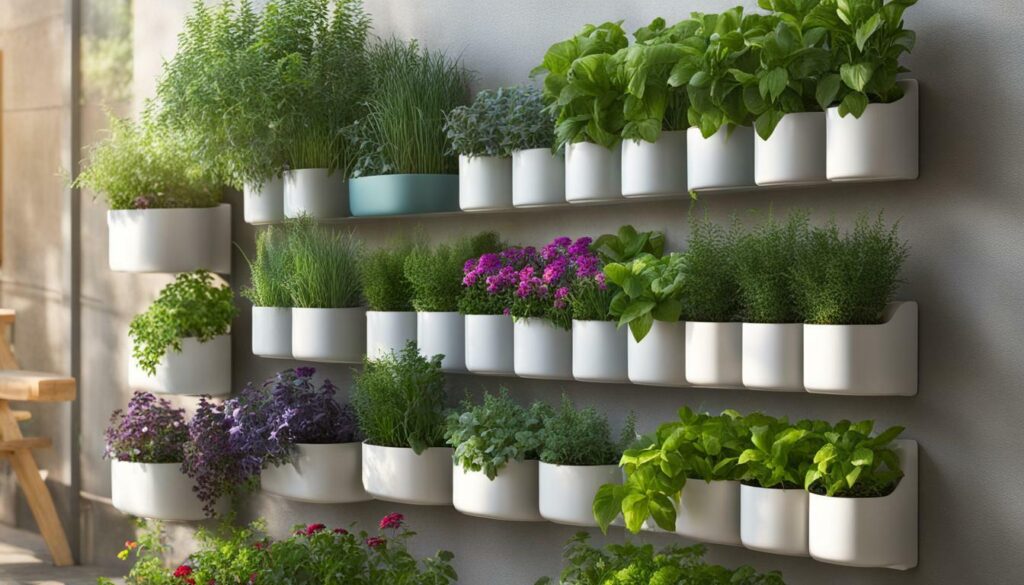
| Vertical Herb Garden Care Checklist |
|---|
| Regularly monitor moisture levels and water accordingly |
| Fertilize herbs with a balanced organic fertilizer |
| Prune herbs to maintain proper growth and airflow |
| Inspect plants for pests and take immediate action if necessary |
| Rotate the vertical garden for even sunlight exposure |
| Watch for signs of nutrient deficiencies or diseases |
Harvesting and Using Herbs from Your Vertical Garden
The joy of a vertical herb garden is in the bountiful harvest it can provide, offering a fresh and flavorful supply of herbs for your culinary and wellness needs. Whether you’re harvesting herbs for cooking, teas, or homemade remedies, a vertical garden can be a convenient and sustainable way to cultivate a variety of herbs. Let’s explore the process of harvesting and using herbs from your vertical garden, along with some tips and ideas to make the most of your herbaceous bounty.Harvesting Tips
When it comes to harvesting herbs from your vertical garden, timing is crucial. As a general rule, it’s best to harvest herbs early in the morning, before the sun has had a chance to evaporate the plant’s essential oils. This is when the flavors and aromas are at their peak. Use a pair of sharp scissors or shears to cut the herb stems just above a pair of healthy leaves or nodes. This will encourage new growth and ensure the plant remains productive. Avoid harvesting more than one-third of the plant at a time to allow for continued growth and vitality.Using Fresh Herbs
Fresh herbs from your vertical garden can elevate any dish with their vibrant flavors and aromas. From salads and soups to marinades and sauces, the possibilities are endless. Experiment with different herb combinations to create unique flavor profiles. For example, a blend of basil, parsley, and thyme can add a burst of freshness to a homemade pasta sauce. Use fresh herbs as garnishes for added visual appeal and flavor enhancement. Remember to wash your harvested herbs thoroughly before use to remove any dirt or pests.Drying and Preserving Herbs
If you find yourself with an abundance of herbs from your vertical garden, drying and preserving them can help extend their shelf life and ensure a steady supply throughout the year. To dry herbs, tie a bundle of stems together and hang them upside down in a well-ventilated area away from direct sunlight. Once dry, remove the leaves from the stems and store them in airtight containers. Alternatively, you can freeze fresh herbs by chopping them finely and placing them in ice cube trays filled with water or olive oil. These herb-infused cubes can be easily added to soups, stews, or sauces for added flavor.| Herb | Harvesting Tips | Usage Ideas |
|---|---|---|
| Basil | Harvest the leaves regularly to encourage bushier growth. Pinch off the top pair of leaves to promote branching. | Use fresh in caprese salads, pesto, or as a garnish for bruschetta. |
| Rosemary | Harvest sprigs by cutting them close to the main stem. Avoid stripping the plant of all its leaves at once. | Use fresh to season roasted vegetables, marinades, or infused oils. |
| Mint | Harvest the leaves regularly to prevent the plant from becoming too woody. Trim the top third of the stems to encourage bushier growth. | Use fresh in drinks like mojitos, infused water, or as a garnish for desserts. |

Troubleshooting Vertical Herb Gardens
As with any gardening endeavor, vertical herb gardens can encounter challenges, but with proper troubleshooting techniques, you can overcome common issues and ensure the success of your plants. Here are some common problems that you may face when growing herbs vertically and how to solve them:
Poor sunlight exposure
One of the key factors for herb growth is sufficient sunlight. If your vertical garden is not receiving enough sunlight, consider relocating it to a sunnier spot or using artificial grow lights to supplement the light. Some herbs, such as mint and parsley, can tolerate partial shade, while others, like basil and rosemary, prefer full sun. Be sure to research the sunlight requirements of each herb and adjust accordingly.
Inadequate drainage
Proper drainage is crucial for the health of your herbs. If your vertical garden is not draining properly and the soil is consistently wet, it can lead to root rot and other issues. Ensure that your containers have drainage holes at the bottom and use well-draining soil mix specifically formulated for herbs. You can also add a layer of gravel or perlite at the bottom of the containers to improve drainage.
Pest infestations
Like any garden, vertical herb gardens are susceptible to pests such as aphids, caterpillars, and mites. Regularly inspect your plants for any signs of pest infestation, such as yellowing leaves, holes, or sticky residue. If pests are present, consider using organic pest control methods such as neem oil, insecticidal soap, or introducing beneficial insects like ladybugs. You can also employ companion planting techniques, planting herbs that repel pests near susceptible ones.
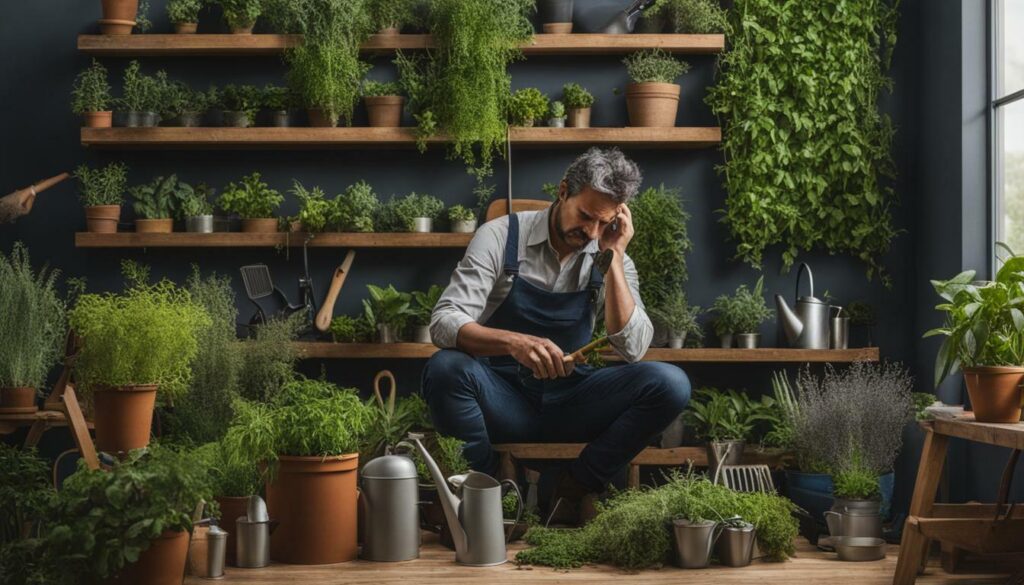
| Common Issue | Solution |
|---|---|
| Poor sunlight exposure | Relocate garden to a sunnier spot or use grow lights |
| Inadequate drainage | Ensure containers have drainage holes, use well-draining soil mix |
| Pest infestations | Regularly inspect plants, use organic pest control methods |
By addressing these common issues, you can troubleshoot and overcome challenges in your vertical herb garden, ensuring healthy growth and bountiful harvests of fresh herbs for your culinary needs.
Inspiring Ideas for Vertical Herb Gardens
Get inspired by these ingenious ideas for vertical herb gardens that will not only maximize your space but also add beauty and uniqueness to your garden area. With the increasing popularity of vertical gardening, there are endless possibilities for creating stunning and functional herb gardens in small spaces.
‘Creating a vertical garden can be a great way to create more space while showcasing your plants in a new and artful way,’ says Luke Dejahang, CEO of Crown Pavillions.
One idea is to use a trellis as a support structure for climbing herbs such as mint, thyme, and rosemary. Attach small pots or planters to the trellis, allowing the herbs to grow upwards and create a vibrant, green wall of herbs. This not only saves space but also provides easy access to the herbs for harvesting and cooking.
Another option is to repurpose old pallets and transform them into vertical herb gardens. Secure the pallets vertically against a wall and insert small pots or planter boxes into the spaces between the slats. Plant a variety of herbs such as basil, parsley, and cilantro in each section, creating a visually appealing and functional herb display. This DIY project adds a rustic touch to your garden while maximizing the use of vertical space.
If you have limited floor space, consider using vertical hanging baskets for your herb garden. Hang the baskets from a sturdy structure, such as a pergola or overhead beams, and plant herbs such as thyme, oregano, and sage in each basket. This allows you to have a compact herb garden that is both decorative and easy to maintain.
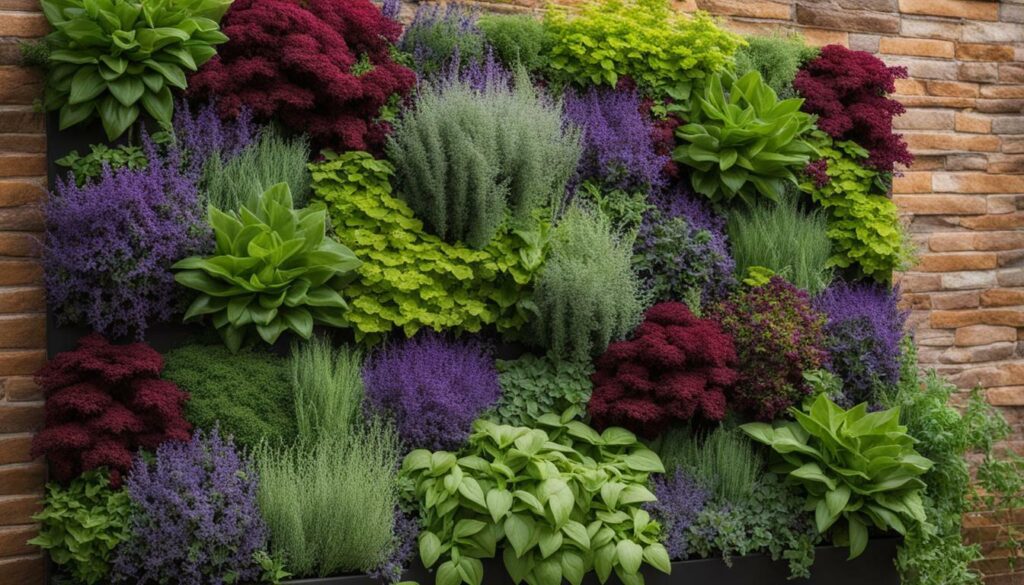
Summary:
Vertical herb gardens are a great way to maximize space while adding beauty and functionality to your garden area. Whether you choose to use a trellis, repurpose pallets, or hang baskets, there are plenty of inspiring ideas to create a unique vertical herb garden. Experiment with different designs, combinations of herbs, and placement to find the perfect vertical garden solution for your space.
Vertical Herb Gardening in Urban Spaces
Vertical herb gardening is particularly advantageous in urban spaces, offering city dwellers a chance to enjoy fresh herbs and greenery even in the midst of concrete and limited outdoor areas. With the rise of urban gardening, people are finding creative ways to maximize their available space and bring the joys of gardening into their urban lifestyles. Whether you have a small balcony, a window ledge, or even just a spare wall, vertical herb gardens provide a practical and visually appealing solution.
One popular method for vertical herb gardening is using trellises or wall-mounted planters. These structures allow herbs to grow vertically, utilizing the space efficiently. Additionally, they create a beautiful display of cascading greenery that adds a touch of nature to urban environments. By carefully selecting the appropriate herbs for your vertical garden based on sunlight and growth habits, you can create a thriving herb garden that not only maximizes space but also provides you with fresh, flavorful herbs for cooking and other purposes.
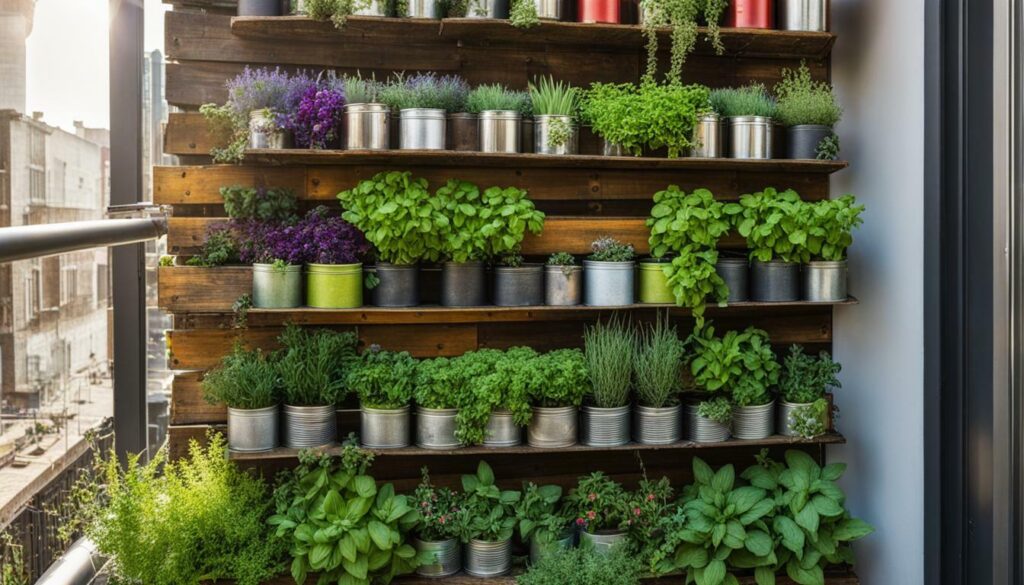
Another option for vertical herb gardening in urban spaces is the use of hanging gardens. By suspending planters from a balcony or other elevated structure, you can create a stunning visual display while maximizing your growing space. Hanging gardens are particularly useful for those with limited floor space or who want to add greenery to areas that would otherwise go unused. They also provide easy access to your herbs, making it convenient to harvest them for culinary purposes.
In addition to trellises and hanging gardens, there are various other techniques and structures that can be used for vertical herb gardening in urban spaces. Wall-mounted pallet planters, stacked plant containers, and vertical hydroponic systems are just a few examples. The key is to be creative and adapt these techniques to suit your available space and personal preferences. With the right design and care, your vertical herb garden can become a beautiful and productive addition to your urban environment.
Benefits of Vertical Herb Gardening in Urban Spaces:
- Maximizes limited space
- Brings nature into urban environments
- Provides easy access to fresh herbs
- Adds visual appeal to walls and balconies
- Enhances air quality and reduces noise pollution
Whether you are an urban dweller looking to make the most of your limited space or simply want to bring a touch of greenery into your urban lifestyle, vertical herb gardening is a practical and rewarding solution. By harnessing the power of vertical space and utilizing creative techniques and structures, you can create a thriving herb garden that not only maximizes space but also enhances the aesthetics of your urban environment.
Environmental Benefits of Vertical Herb Gardening
Vertical herb gardening not only benefits the gardener but also the environment, making it a sustainable and eco-friendly gardening practice. By utilizing vertical space and creating thriving herb gardens, gardeners can contribute to several environmental advantages.
One of the key benefits of vertical herb gardening is the efficient use of space. By growing herbs vertically, gardeners can maximize their growing area and produce a greater quantity of herbs in a limited space. This is particularly beneficial for urban environments where land is scarce. Vertical gardens also help reduce the need for additional land clearing, preserving natural habitats and promoting biodiversity in urban areas.
In addition, vertical herb gardens often require less water compared to traditional gardens. The design of vertical structures allows for efficient water usage, as water can be directed directly to the herbs’ roots, minimizing water waste through evaporation or runoff. This water-saving feature not only conserves water resources but also reduces the gardener’s water bill.
Furthermore, vertical herb gardening can contribute to improved air quality. Herbs are natural air purifiers, absorbing pollutants and releasing oxygen. By growing herbs vertically, gardeners can increase the number of plants in a given area, leading to enhanced air purification and cleaner air. This is especially beneficial in urban environments where air pollution is a common concern.
Table: Comparison of Environmental Benefits of Vertical Herb Gardening
| Environmental Benefits | Vertical Herb Gardening | Traditional Gardening |
|---|---|---|
| Space utilization | Maximize limited space | Require more land |
| Water conservation | Efficient water usage | Higher water consumption |
| Air purification | Increased number of plants | Limited number of plants |
Vertical herb gardening not only benefits the gardener but also the environment, making it a sustainable and eco-friendly gardening practice.
Overall, vertical herb gardening provides numerous environmental benefits, including efficient space utilization, water conservation, and improved air quality. By adopting this gardening technique, individuals can contribute to a greener and healthier environment, even in small or urban spaces.
Conclusion
Creating a vertical garden for herbs allows you to maximize your space while enjoying the convenience and satisfaction of growing your own flavorful herbs. Whether you have a small balcony, a back porch, or even just a window ledge, vertical gardening is a versatile solution that can transform any limited space into a thriving herb garden.
By utilizing vertical gardening techniques, you can make the most of your available space and create a beautiful green oasis. Vertical gardens not only provide a practical solution for small spaces but also add aesthetic appeal to any environment. They can serve as a focal point or a living wall, bringing life and vibrancy to your home or urban space.
When choosing herbs for your vertical garden, consider factors such as sunlight, space, and growth habits. Select herbs that are suitable for vertical growth and can tolerate the conditions they will be exposed to. By carefully planning your herb selection, you can create a diverse and thriving vertical garden that provides a variety of flavors and aromas for your culinary creations.
Designing the layout of your vertical garden is essential for both functionality and aesthetics. Experiment with different arrangements, incorporating trellises, hanging gardens, and wall-mounted planters to create a visually appealing and efficient use of space. By creating a well-designed layout, you can ensure that your herbs receive adequate sunlight, water, and nutrients for healthy growth.
Maintaining a vertical herb garden requires regular care and attention. Proper watering, fertilizing, pruning, and pest control are necessary to keep your herbs healthy and productive. By following these essential care and maintenance practices, you can enjoy a bountiful harvest of fresh herbs throughout the growing season.
Harvesting herbs from your vertical garden is an enjoyable and rewarding experience. Harvesting at the right time ensures maximum flavor and potency. Once harvested, you can utilize your herbs in a variety of culinary applications, teas, and homemade remedies, adding freshness and aromatic flavors to your dishes.
While vertical herb gardening can sometimes come with challenges, such as pests, diseases, and environmental factors, there are effective troubleshooting strategies available. By identifying and addressing common issues, you can overcome these challenges and maintain a healthy and productive vertical herb garden.
Vertical herb gardens offer endless possibilities for creativity and inspiration. Explore unique designs, DIY projects, and innovative repurposing of materials to create a one-of-a-kind vertical garden that suits your personal style and preferences. Let your imagination run wild and create a visually stunning herb garden that not only maximizes your space but also adds beauty and charm to your surroundings.
In urban spaces, vertical herb gardening provides an excellent solution for city dwellers who want to have fresh herbs at their fingertips. Despite limited outdoor space, vertical gardens allow urbanites to cultivate their own flavorful herbs, adding a touch of green to their balconies, rooftops, or windowsills. Urban gardening not only provides a source of fresh, organic herbs but also promotes a sense of connection to nature in the midst of a bustling city.
Lastly, vertical herb gardening offers significant environmental benefits. By growing your own herbs, you reduce the miles they would typically travel from the farm to your table, reducing carbon emissions and supporting a more sustainable food system. Vertical gardens also contribute to urban biodiversity, attracting pollinators and beneficial insects, and improving air quality. By adopting vertical herb gardening practices, you are making a positive impact on the environment.
In conclusion, creating a vertical garden for herbs allows you to maximize your space, cultivate fresh, flavorful herbs, and contribute to a more sustainable and vibrant environment. With careful planning, design, and maintenance, you can create a beautiful and productive vertical herb garden that brings joy and freshness to your daily life.
Can the Railscales Vertical Garden Clip be used for growing herbs in a vertical garden?
Yes, you can easily maximize gardening space with Railscales by using their Vertical Garden Clip to grow herbs in a vertical garden. It allows you to securely attach pots and containers to a vertical surface, making it perfect for creating a functional and space-saving herb garden.
FAQ
Q: What are the benefits of vertical gardening for small spaces?
A: Vertical gardening in small spaces allows for efficient use of space, convenient access to plants, and adds aesthetic appeal to the area.
Q: How do I choose the right herbs for my vertical garden?
A: When selecting herbs for a vertical garden, consider factors such as sunlight requirements, available space, and the growth habits of different herbs.
Q: What are some design tips for creating a vertical garden layout?
A: When designing a vertical garden, consider incorporating trellises, hanging gardens, or wall-mounted planters to maximize space and create an appealing layout.
Q: What techniques and structures can be used for vertical gardening?
A: Some common techniques and structures for vertical gardening include trellises, hanging baskets, stacked planters, and wall-mounted systems.
Q: How do I care for and maintain a vertical herb garden?
A: Proper care and maintenance of a vertical herb garden includes regular watering, fertilizing, pruning, and pest control measures.
Q: What are some tips for harvesting and using herbs from a vertical garden?
A: Harvest herbs from your vertical garden by snipping off the leaves or stems as needed. Fresh herbs can be used in cooking, teas, and homemade remedies.
Q: What are common issues and troubleshooting methods for vertical herb gardens?
A: Common issues in vertical herb gardening include pests, diseases, and environmental factors. Troubleshooting methods may include using organic pest control, proper watering techniques, and addressing any nutrient deficiencies.
Q: Can you provide inspiring ideas for vertical herb gardens?
A: Some creative ideas for vertical herb gardens include using repurposed materials, creating unique designs, and DIY projects to add visual interest to your space.
Q: How can vertical herb gardening be done in urban spaces?
A: Vertical herb gardening is ideal for urban spaces with limited land. It allows city dwellers to grow their own herbs, even in balconies, rooftops, or small gardens.
Q: What are the environmental benefits of vertical herb gardening?
A: Vertical herb gardening helps conserve water, improves air quality, and contributes to urban biodiversity, making it an environmentally friendly choice.
Q: Can you provide a conclusion for the article on vertical gardening for herbs?
A: Creating a vertical garden for herbs is an effective way to maximize your space, cultivate fresh herbs, and create an aesthetically pleasing and environmentally friendly garden. With careful planning and maintenance, anyone can enjoy the benefits of vertical herb gardening, regardless of their space limitations.

